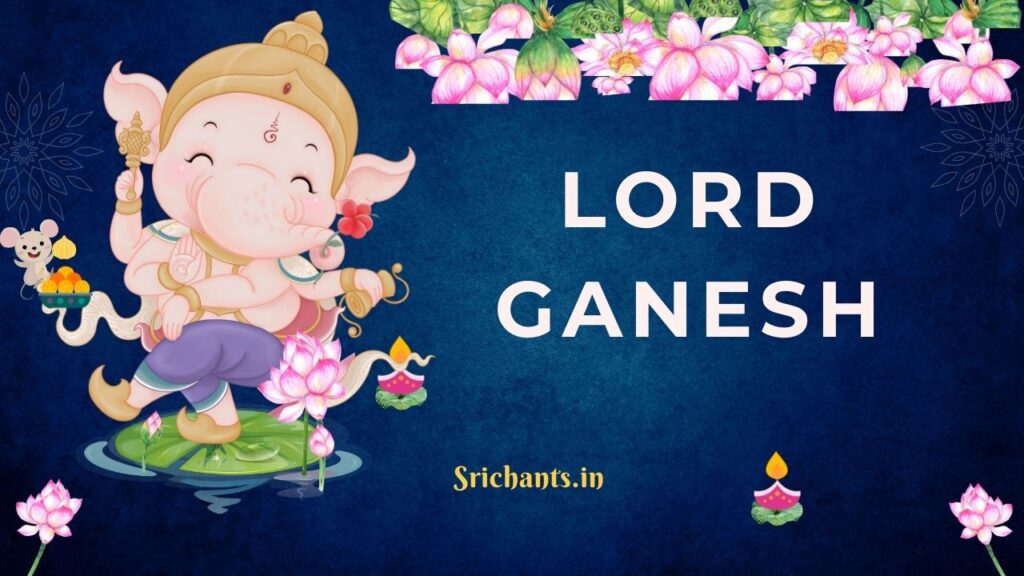Exploring the 32 Forms of Lord Ganesha: A Divine Tapestry of Manifestations
Lord Ganesha, the Elephant-headed God, is of great importance in Hinduism. Lord Ganesha is not restricted to a single form, acting as the remover of obstacles and the bestower of wisdom, prosperity, and good fortune. Rather, He appears in a variety of divine incarnations, each of which carries its own profound significance and symbolism. In this investigation, we delve into the captivating realm of the 32 forms of Lord Ganesha, elucidating their distinctive attributes and importance within the Hindu spiritual tradition.
1. Bala Ganapati: The Childlike Deity of Abundance
Bala Ganapati, also referred to as “the Childlike,” is a golden-hued representation of Lord Ganesha. He carries a banana, mango, sugar cane, and jackfruit in his hands, which represent the earth’s fertility and abundance. The modaka, his preferred confection, is stored in his trunk, symbolizing the sweetness of life’s bounties.
2. Taruna Ganapati: The Youthful Deity of Energy
Taruna Ganapati, also known as “the Youthful,” is a personification of youthful vitality and enthusiasm. He caries a noose, goad, modaka, wood apple, rose apple, His broken tusk, a sprig of paddy, and a sugar cane stalk with eight arms. His radiant red hue symbolizes the emergence of youth and vitality.
3. Bhakti Ganapati: The Deity of Devotion and Love
Bhakti Ganapati, who is adorned with blossoms and shines like the full moon during the harvest season, is a symbol of love and devotion. He possesses a bowl of delicious payasa pudding, a coconut, a banana, and a mango. Devotees are reminded of the power of devotion in their spiritual journey by his presence, which brings pleasure and serenity.
4. Vira Ganapati: The Valiant Warrior Deity
Vira Ganapati, who is also referred to as “the Valiant Warrior,” establishes a commanding stance. The power of the mind is symbolized by the multiple weapons that adorn his sixteen limbs. The following weapons are included: a goad, projectile, bow, arrow, sword, shield, spear, mace, battleaxe, trident, and more. The courage and fortitude required to surmount challenges are symbolized by Vira Ganapati.
5. Shakti Ganapati: The Deity of Power and Protection
Shakti Ganapati, “the Powerful,” is depicted with one of His shaktis on his knee, symbolizing the sacred feminine energy. He bestows blessings with the abhaya mudra and wields a garland, noose, and goad in his capacity as the guardian of the householder. He emanates protection and vigor due to his orange-red complexion.
6. Dvija Ganapati: The Twice-Born Deity of Discipline
The “Twice-Born,” Dvija Ganapati, is cloaked in a moon-like hue and possesses four heads. He underscores the significance of disciplined effort in our spiritual pursuits by holding a ligature, goad, ola leaf scripture, staff, water vessel, and japa beads. The wisdom that is acquired through rigorous practice is symbolized by Dvija Ganapati.
7. Siddhi Ganapati: The Deity of Accomplishment and Self-Mastery
Siddhi Ganapati, “the Accomplished,” radiates a golden-yellow hue, signifying self-mastery and accomplishment. He is seated in a relaxed manner, with a bouquet of flowers, an axe, mango, sugarcane, and a delectable sesame treat in his trunk. Devotees are motivated to achieve achievement in all of their endeavors by Siddhi Ganapati.
8. Ucchishta Ganapati: The Deity of Blessed Offerings
Ucchishta Ganapati, also known as “the Lord of Blessed Offerings,” is the protector of tradition and culture. He seats with His Shakti, holding a vina, pomegranate, blue lotus flower, japa mala, and a sprig of fresh paddy, and has a blue complexion and six arms. Ucchishta Ganapati serves as a reminder of the significance of safeguarding and honoring our cultural heritage.
9. Vighna Ganapati: The Lord of Obstacles
Vighna Ganapati, also known as “the Lord of Obstacles,” is resplendent in gold and gemstones. A noose, goad, tusk, modaka, conch, discus, a bouquet of flowers, sugar cane, flower arrow, and an axe are all held by his eight limbs. The ability to surmount obstacles and challenges on our spiritual journey is symbolized by Vighna Ganapati.
10. Kshipra Ganapati: The Quick-Acting Deity of Boons
Kshipra Ganapati, also known as “the Quick-Acting,” is an attractive individual with a reddish complexion. He is the bestower of blessings and exhibits a fractured tusk, a noose, a goad, and a sprig of the kalpavriksha tree, which satisfies all desires. He carries a small pot of precious jewels in his uplifted trunk, which symbolizes the rapid fulfillment of wishes.
11. Heramba Ganapati: The Protector of the Weak
Heramba Ganapati, who is white and has five faces, is depicted riding a large lion. While holding a noose, japa beads, axe, hammer, tusk, garland, fruit, and modaka, he extends gestures of protection and benediction. The compassionate protector of the feeble and vulnerable is symbolized by Heramba Ganapati.
12. Lakshmi Ganapati: The Pure White Deity of Success
Success and affluence are associated with Lakshmi Ganapati, the pure white deity. He is seated and is accompanied by Wisdom and Achievement. He is holding a green parrot, a pomegranate, a sword, a goad, a noose, a sapling of the kalpavriksha tree, and a water vessel. Lakshmi Ganapati symbolizes the realization of both material and spiritual aspirations.
13. Maha Ganapati: The Great Deity of Prosperity and Wisdom
Maha Ganapati is three-eyed and red-complexed, and he is accompanied by one of His shaktis. He possesses a pomegranate, blue lily, sugar-cane bow, discus, noose, lotus, paddy sprig, mace, and a pot of jewels, in addition to his tusk. Maha Ganapati is the embodiment of divine blessings, wisdom, and prosperity.
14. Vijaya Ganapati: The Victorious Deity of Success
On His resourceful mushika (mouse), Vijaya Ganapati is depicted with a radiant crimson hue. He is referred to as “the Victorious” and bestows triumph upon His followers. The broken tusk, elephant goad, noose, and a luscious golden mango, his favored fruit, comprise his insignia. Vijaya Ganapati motivates us to attain success in all facets of life.
15. Nritya Ganapati: The Divine Dancer
Nritya Ganapati, also known as “the Dancer,” is a golden deity who is joyful and wears rings on his fingertips. He prancingly struts beneath the kalpavriksha tree, symbolizing exuberant activity and pleasure, while holding a tusk, goad, noose, and modaka sweet. Nritya Ganapati inspires us to convey our creativity and experience joy through artistic pursuits and dance.
16. Urdhva Ganapati: The Elevated Deity of Knowledge
“The Elevated” Lord of golden hue, Urdhva Ganapati, is seated with one of His shaktis on His left knee. He possesses a blue water lily, an arrow, a sugar cane bow, a lotus, and a sprig of paddy in each of his six palms. The pursuit of knowledge and spiritual development is symbolized by Urdhva Ganapati.
17. Ekakshara Ganapati: The Deity of Single-Syllable Mantra
The “Lord of the Single-Syllable” (gam) is Ekakshara Ganapati, who is distinguished by his crimson complexion and attire. He is three-eyed and wears a crescent moon on his headdress. He holds a pomegranate, ligature, and goad while sitting in the lotus pose upon Mushika, offering the boon-giving gesture. The potency of the single-syllable mantra in spiritual practice is symbolized by Ekakshara Ganapati.
18. Varada Ganapati: The Boon-Giving Deity
Varada Ganapati, also known as “the Boon-Giver,” is distinguished by his prominent third eye of wisdom. He encloses a pot of jewels in his trunk and carries a noose, goad, and dish of honey. The crescent moon adorns His crown, and His shakti is by His side. Varada Ganapati symbolizes the fulfillment of desires and the bestowal of blessings.
19. Tryakshara Ganapati: The Deity of Three Syllables
Tryakshara Ganapati, also known as “the Lord of Three Letters” (A-U-M), is characterized by a golden tint and large, floppy ears that are adorned with fly whisks. He is frequently seen clutching a sweet modaka in his trunk, while also carrying the broken tusk, goad, noose, and mango. The sacrosanct syllable AUM and its importance in spiritual practice are symbolized by Tryakshara Ganapati.
20. Kshipra Prasada Ganapati: The Quick Rewarder Deity
Kshipra Prasada Ganapati, also known as “the Quick Rewarder,” occupies a kusha-grass throne. The manifest universe is symbolized by his large girth. He is armed with a noose, goad, tusk, lotus, pomegranate, and a sapling from the wish-fulfilling tree. Kshipra Prasada Ganapati epitomizes the rewards of sincere devotion and the rapid fulfillment of desires.
21. Haridra Ganapati: The Deity of Brightness and Positivity
Haridra Ganapati, the golden deity, is depicted sitting serenely on a luxurious, regal throne, adorned with brilliant yellow vestments. In addition to His tusk and a modaka, He possesses a sharp goad to motivate devotees and a noose to secure them. The capacity to overcome negativity, positivity, and brightness are all embodied by Haridra Ganapati.
22. Ekadanta Ganapati: The Deity of Single Tusk
The blue color and sizable abdomen of Ekadanta Ganapati are symbolic attributes. The fractured right tusk symbolizes sacrifice, the laddu sweet represents enjoyment, the axe represents cutting the bonds of ignorance, and prayer beads symbolize japa (chanting). Ekadanta Ganapati motivates followers to separate from material desires and develop spiritual wisdom.
23. Srishti Ganapati: The Deity of Manifestation and Creation
Srishti Ganapati is the lord of joyful “Manifestation,” as he rides on his docile and friendly mouse. A noose, goad, perfect mango, and His tusk are held by this active God, who has a red complexion. These objects symbolize selfless sacrifice. Srishti Ganapati serves as a reminder of the capacity to actualize our aspirations and establish a harmonious world.
24. Uddanda Ganapati: The Enforcer of Dharma
Uddanda Ganapati, also referred to as the “Enforcer of Dharma,” enforces the principles of ethical behavior. His ten hands are adorned with a blue lily, sugar cane, a mace, a lotus flower, a sprig of paddy, a pomegranate, a noose, a garland, and his fractured tusk. It is crucial to uphold moral principles and preserve harmony, as exemplified by Uddanda Ganapati.
25. Rinamochana Ganapati: The Liberator from Bondage
Rinamochana Ganapati frees humanity from the bonds of remorse and servitude. Red silks adorn his alabaster complexion figure. His favored fruit is the rose apple, and he carries a noose and a goad, as well as a milk-white tusk. Rinamochana Ganapati provides comfort and liberation from the shackles that impede our progress.
26. Dhundhi Ganapati: The Sought After Deity
Dhundhi Ganapati, who bears a red hue, is depicted holding a strand of rudraksha beads, his fractured tusk, an axe, and a small pot of precious gems. It is believed that these jewels symbolize the treasury of awakenings that He reserves for all fervent devotees. The fulfillment of desires and the rewards of sincere spiritual pursuits are symbolized by Dhundhi Ganapati.
27. Dvimukha Ganapati: The Double-Faced Deity
Dvimukha Ganapati, who was referred to as Janus by the Romans, possesses two divergent features and is capable of perceiving all directions. His bejeweled headdress is affixed to his blue-green form, which is attired in red silk. He is armed with a noose, goad, his tusk, and a pot of jewels. Dvimukha Ganapati symbolizes the capacity to perceive both the inner and outer realms with clarity.
28. Trimukha Ganapati: The Three-Faced Deity of Contemplation
Trimukha Ganapati, the contemplative “three-faced” Lord, is depicted sitting on a golden lotus, grasping a noose, goad, and vessel of nectar, while reciting His beads. With the right hand, he extends a gesture of protection, while the left hand indicates blessings. The significance of self-reflection, contemplation, and the pursuit of higher knowledge is symbolized by Trimukha Ganapati.
29. Sinha Ganapati: The Deity of Strength and Fearlessness
Sinha Ganapati, who is white in color, symbolizes strength and fearlessness by riding a lion and holding another lion in one hand. Additionally, he possesses a lotus blossom, a floral bouquet, a vina, a kalpavriksha sprig, and a pot of jewels. Devotees are motivated by Sinha Ganapati to develop inner fortitude, courage, and the ability to surmount fear.
30. Yoga Ganapati: The Deity of Meditation and Yoga
Yoga Ganapati is in a meditative pose, with his ankles strapped, as he is engrossed in mantra japa. He possesses a ligature, prayer beads, sugar cane stalk, and yoga staff in his hands. His form is adorned with blue garments, and his color is reminiscent of the morning sun. The practice of meditation, inner calm, and the union of body, mind, and spirit is symbolized by Yoga Ganapati.
31. Durga Ganapati: The Invincible Deity
The flag of victory over darkness is waved by Durga Ganapati. The bow and arrow, noose and goad, prayer beads, broken tusk, and rose apple are all held by this magnificent deity, who is dressed in scarlet and has a deep gold hue. Durga Ganapati symbolizes the triumph of divine energy over negativity and the certainty of success in all endeavors.
32. Sankatahara Ganapati: The Dispeller of Sorrow
Sankatahara Ganapati, “the Dispeller of Sorrow,” is depicted as a blue-robed figure seated on a red lotus blossom, with a sun-like appearance. He is currently gesturing the boon-granting varada mudra while holding a noose, a goad, and a basin of pudding. Sankatahara Ganapati provides solace and respite from pain and suffering, reminding devotees of the divine support that is available during difficult times.
In summary, the 32 manifestations of Lord Ganesha provide a profound understanding of the multifaceted nature of divinity. The diverse spiritual requirements and aspirations of devotees are met by each form, which possesses its own symbolism and significance. These manifestations of Lord Ganesha serve as a reminder of the depth and breadth of Hindu spirituality, where the divine can be encountered in an infinite number of ways, thereby assisting us in our pursuit of enlightenment, prosperity, and wisdom.
#ganesh #32forms #formsofganesha








